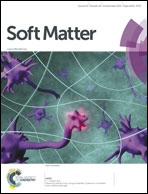Turning up the heat on wormlike micelles with a hydrotopic salt in microfluidics†
Abstract
In equilibrium, wormlike micelles can transition from entangled to branched structures with increasing surfactant concentrations and ionic strength. Under flow conditions, structural transition of micellar solutions can follow very different trajectories. In this study we consider the flow of a semi-dilute wormlike micellar solution through an array of microposts, with focus on its rheological and microstructural evolutions. Specifically, the micellar solution (precursor) contains cationic surfactant cetyltrimethylammonium bromide (CTAB) and hydrotropic organic salt 3-hydroxynaphthalene-2-carboxylate (SHNC). We report the formation of a flow induced structured phase (FISP), with entangled, branched, and multi-connected micellar bundles, evidenced by electron microscopy and small-angle neutron scattering (SANS). By integrating gold-etched microheaters with the micropost design in a microfluidic device, we investigate the localized temperature effect on both the precursor and FISP, with complementary investigations from SANS. We observe that the FISP does not completely disintegrate at high temperatures, whereas, the precursor exhibits shortening of wormlike micelles as temperature increases. We also correlate the microstructure of both FISP and precursor with two point passive microrheology and bulk rheology characterizations.


 Please wait while we load your content...
Please wait while we load your content...